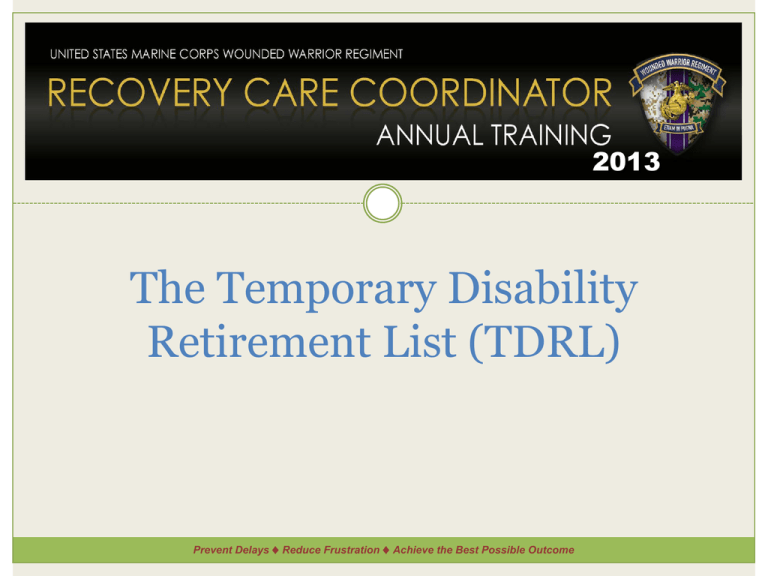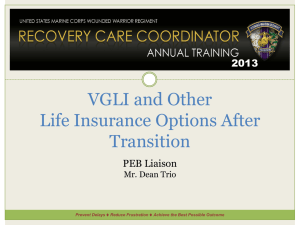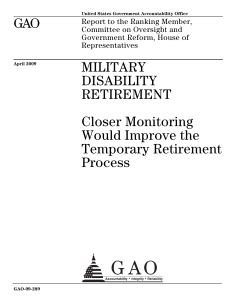TDRL - United States Marine Corps Wounded Warrior Regiment
advertisement

2013 The Temporary Disability Retirement List (TDRL) Prevent Delays ♦ Reduce Frustration ♦ Achieve the Best Possible Outcome Terminal Learning Objectives 2 As an RCC help Marines and families… Prevent Delays Explain clearly who the Marine must call to schedule Periodic Physical Examinations (PPE) Explain the difference between TDRL and PDRL Explain the consequences of being administratively removed from TDRL Discuss the possible outcomes of Periodic Physical Examinations and prepare the family to deal with them financially Reduce Frustration Achieve the Best Possible Outcome Ensure the Marine and family understand the process to schedule the Periodic Physical Examination Document the best contact methods to facilitate PPE orders Prevent Delays ♦ Reduce Frustration ♦ Achieve the Best Possible Outcome Enabling Learning Objectives 3 Describe the criteria used to determine whether a Marine is placed on TDRL or PDRL Identify the benefits received by Marines while on the TDRL Describe the consequences of being medically separated while on the TDRL Describe the consequences of being administratively removed from the TDRL Describe the consequences of being moved from the TDRL to the PDRL Identify the required Periodic Physical Examinations (PPE) Describe the process required to schedule the Periodic Physical Examinations Identify the role of the Marine Corps Disability Section (MMSR-4), the PEBLO, and the TDRL Coordinator in executing the TDRL Distinguish between the initial VA rating and the initial DoD rating and understand that changes to one does not affect the other Recognize the challenges faced by the Marine Corps in executing the TDRL Prevent Delays ♦ Reduce Frustration ♦ Achieve the Best Possible Outcome Benefit Profile 4 Frequency 40-50% of Marines assigned to the Recovery Care Program will be placed on the TDRL Drawbacks N/A (Marines do not choose to be placed on the TDRL) Importance to Marine While on the TDRL Marines receive benefits including a military retirement check, a retired ID card, and eligibility for TRICARE. However, failure to comply with the requirements of the TDRL will result in the loss of all of their retirement benefits. Challenges Approximately 15% of Marines on TDRL are administratively removed, losing all of their benefits. Improving on this has been identified as a point of emphasis by the USMC leadership The Marine must remain actively engaged in the process after transition making education and communication extremely important Prevent Delays ♦ Reduce Frustration ♦ Achieve the Best Possible Outcome Rules of the Road 5 Speak to Marines who will be transferred to the TDRL about their responsibilities and the consequences of not completing them Encourage the Marine to actively engage the NMCM or DISC that is assigned follow-on care coordination responsibilities Counsel Marine to be prepared for changes in benefits N/A Express any personal opinion about the TDRL Prevent Delays ♦ Reduce Frustration ♦ Achieve the Best Possible Outcome IDES Outcomes 6 TDRL 45% PDRL 11% Separated w/ Benefits 33% Separated w/o Benefits Continued on Military Service Based on the first six months of 2013 1% TDRL Found Fit for Duty Separated w/o Benefits Fit for Duty by Presumption MEB Terminated for Medical Reasons Remain on Active Duty 8% PDRL Administrative Separation Voluntary Retirement or Separation Separated with Benefits Medical Separation or Retirement 90% Prevent Delays ♦ Reduce Frustration ♦ Achieve the Best Possible Outcome Non-Medical Separations 2% Benefits on the TDRL 7 Retiree Benefits on TDRL DoD awarded retired pay: • Subject to offset or waiver if receiving VA compensation • Amount is subject to change • Taxable income if not combat related TRICARE (if Marine elects to enroll) Retired / Dependent ID cards • Base Access • Commissary and Exchange privileges Survivor Benefit Program (automatic unless declined) Combat Related Special Compensation (if eligible) Concurrent Receipt of Disability Payments (if eligible) DoD Retired Pay on TDRL Based on Public Law, Marines placed on TDRL with a DoD disability rating of 30%, 40%, or 50% will receive 50% of base pay. Those with a 60% or 70% awards will receive that percentage. 80% and above will receive maximum allowable by Public Law which is 75%. Original TDRL award does not change until case finalized. Changes to VA compensation do not affect DoD rating. Marines transferred from TDRL to PDRL will receive DoD disability retired pay at the rate equivalent to their final DoD disability rating award. • • • 30% = 30% 50% = 50% 90% = 75% Prevent Delays ♦ Reduce Frustration ♦ Achieve the Best Possible Outcome Outcomes of the TDRL 8 • The TDRL is TEMPORARY. Transferred to PDRL Marine will be permanently retired. All DoD benefits / eligibilities of the TDRL are now permanent. Separated with Benefits Marine will lose all retiree benefits. Severance check may be recouped by VA comp received. Marine is entitled to a formal board. Found Fit for Duty Marine may re-enlist if he meets all retention requirements such as PFT/CFT. Marine is entitled to a formal board. Otherwise he will be separated without benefits. Administratively Removed All retirement benefits suspended until Marine complies with the TDRL requirements (i.e., attends Periodic Physical Examination) • PDRL is generally the desired outcome. IDES Complete. Marines Accepts Findings Placed on TDRL Prevent Delays ♦ Reduce Frustration ♦ Achieve the Best Possible Outcome Benefits after the TDRL 9 Benefit TDRL Outcome PDRL Separated with Benefits* Fit for Duty* Administratively Removed* Military Retired Pay Continues; amount recalculated based on final rating Stopped Stopped Suspended TRICARE Eligibility continues Coverage terminates immediately Coverage terminates immediately Coverage suspended immediately Survivor Benefit Program (SBP) Remains in program if enrolled, premiums will adjust with retired pay Removed from program if enrolled Removed from program if enrolled Premiums and benefit suspended immediately ID Card Access to base, commissary, and exchange Continues permanently ID card will not be renewed ID card will not be renewed ID card will not be renewed Combat Related Special Compensation (CRSC) Continues; amount recalculated based on final rating Stopped Stopped Payments are suspended immediately Concurrent Receipt of Disability Payments (CRDP) Continues; amount recalculated based on final rating N/A – Marine will be converted to a normal retirement N/A – Marine will be converted to a normal retirement N/A – Marine will be converted to a normal retirement *Marines eligible for a normal retirement based on 20 years of service will be converted to a normal retirement unless transferred to the PDRL Prevent Delays ♦ Reduce Frustration ♦ Achieve the Best Possible Outcome TDRL vs PDRL 10 Placement on the TDRL indicates that Marine’s condition is not STABLE for disability rating purposes. The severity of the Marine’s disability does not always influence the determination of placement on TDRL or PDRL Marines must go through the IDES to be placed on the TDRL Marines do not choose to be placed on the TDRL, the decision is made by the PEB Prevent Delays ♦ Reduce Frustration ♦ Achieve the Best Possible Outcome Periodic Physical Examinations 11 The Marine must attend Periodic Physical Examinations while on the TDRL Schedule: • 6 months (PTSD only) • 18 months • 3 years • 5 years • Note: 5 years is the maximum time on the TDRL; after the final PPE the Marine will be moved to the PDRL if the disability persists Failure to attend may result in administrative removal from the TDRL The Marine is responsible for providing MMSR-4 with reliable post-service contact info to include an up to date address to receive orders WWCC can help facilitate Prevent Delays ♦ Reduce Frustration ♦ Achieve the Best Possible Outcome The Periodic Physical Examination Process 12 Schedule Appointment Attend Appointment Follow-Up MMSR-4 contacts Marine (approximately 6 months before PPE is required) Marine attends appointment at MTF Records are sent by the MTF to the Physical Evaluation Board (PEB) MMSR-4 informs Marine which Military Treatment Facility (MTF) will conduct the PPE Marine completes travel claim and sends it to MMSR-4 PEB determines whether each condition is stable, and if so determines the final rating Marine must call the MTF and speak to the TDRL coordinator to schedule the PPE MMSR-4 processes the travel claim and submits to DFAS for payment PEB mails findings and Election of Options directly to the Marine Marine must call MMSR-4 to give appointment information DFAS reimburses the Marine for travel Marine must complete Election of Options and return to the PEB MMSR-4 sends Marine the Invitational Travel Order and travel claim Marine Corps Disability Section (MMSR-4) 703-784-9308 703-784-9309 703-784-9321 Prevent Delays ♦ Reduce Frustration ♦ Achieve the Best Possible Outcome See next slide Determining the TDRL Outcome 13 Start Attended PPE? No Periodic Physical Examinations are required at 6 months (PTSD only), 18 months, 36 months, and 5 years Yes All conditions stable? Yes No Admin Remove from TDRL All conditions fitting? Find Fit For Duty Yes No On TDRL 5 years? MMSR-4 coordinates the scheduling of the PPE and is responsible for administratively removing a Marine who does not attend Conditions are evaluated by the Physical Evaluation Board at the Washington Navy Yard based on the examinations conducted No Marine is entitled to a Formal Board and should consult an IDES attorney Yes New (Final) Rating 10%-20% ? Yes Separate with Benefits No Stay on TDRL Prevent Delays ♦ Reduce Frustration ♦ Achieve the Best Possible Outcome Move to PDRL Key Points for Marines on TDRL 14 Stay in Touch Attend PPEs Be Prepared • Marines need to keep MMSR-4 informed of their contact info and mailing address: 703-784-9308, 703-784-9309, 703-784-9321 • Marines should stay in touch with the DISC or the WWCC for assistance • MMSR-4 will provide Invitational Travel Orders to the Marine to attend the Periodic Physical Examination. Marine MUST liquidate travel claim upon completion of all Government funded travel. • The TDRL is TEMPORARY • Changes to the Marine’s benefits are likely Prevent Delays ♦ Reduce Frustration ♦ Achieve the Best Possible Outcome Common Pitfalls Why do Marines Miss Their PPEs? Discussion: How can an RCC help avoid these pitfalls? • Marine moves and does not remember to update MMSR-4 with the address • Marine gets frustrated with MMSR-4 or TDRL Coordinator’s customer service and “gives up” • Marine’s DoD retired pay is fully offset (i.e., waived) by VA awarded disability compensation and he does not realize that continued TRICARE coverage is tied to scheduling and attending the PPEs. Most often, loss of TRICARE benefits impact the dependents. • Marine believes that his VA medical appointments satisfy the PPE requirement 15 Prevent Delays ♦ Reduce Frustration ♦ Achieve the Best Possible Outcome Common Pitfalls Other Challenges with the TDRL Discussion: How can an RCC help avoid these pitfalls? • Marine is unaware that he can be found FIT for duty and lose all previously awarded DoD retirement benefits • Marine is not prepared for a reduction in his final disability rating and DoD disability retired pay • Marines with a final DoD disability rating of 30% or 40% do not understand that retirement check will decrease when he is moved to the PDRL 16 Prevent Delays ♦ Reduce Frustration ♦ Achieve the Best Possible Outcome Resources 17 Basic Resources Advanced Resources Physical Evaluation Board Liaison Officer (PEBLO) Various Will brief Marine when presenting findings Marine Corps Disability Section (MMSR-4) 703-784-9308 703-784-9309 703-784-9321 WWR External Fact Sheet https://ehqmc.usmc.mil/sites/wwr/wrc/External% 20Fact%20Slick%20Sheets/Temporary%20Disabili ty%20Retirement%20List%20Slick%20Sheet.pdf Wounded Warrior Regiment PEB Liaison Dean Trio 703-432-1856 WWR Internal Fact Sheet https://ehqmc.usmc.mil/sites/wwr/wrc/Internal% 20Slick%20Fact%20Sheets/TDRL%20Outreach%2 0Fact%20Sheet.pdf IDES Attorney Various Can assist Marine at any stage Prevent Delays ♦ Reduce Frustration ♦ Achieve the Best Possible Outcome Questions 18 Prevent Delays ♦ Reduce Frustration ♦ Achieve the Best Possible Outcome Knowledge Check 19 GySgt Jefferson is placed on the TDRL with a rating of DoD: 30; VA: 30. His military retirement is not fully offset (i.e., waived). After his final PPE he is placed on the PDRL with the same ratings. What will happen to his DoD retired pay? It will go up It will go down It will stay the same It will be converted to Euros Prevent Delays ♦ Reduce Frustration ♦ Achieve the Best Possible Outcome Knowledge Check 20 At his three year PPE, the PEB determines LCpl Tillotson’s disability to be permanent & stable with a combined final rating of 20%. He has appealed through the PEB Formal Board with no change. What will happen? The Marine will lose his TRICARE coverage The Marine will need to schedule his final PPE The Marine will be placed on the PDRL The Marine will automatically be enrolled in the Survivor Benefits Program Prevent Delays ♦ Reduce Frustration ♦ Achieve the Best Possible Outcome Knowledge Check 21 Cpl MacEwen misses her PPE and is administratively removed from the TDRL. What are the consequences? Her TRICARE coverage will be suspended She will no longer receive her VA disability pay She will have to pay back any GI Bill benefits that she has drawn She will not be able to receive a new retired ID card A only B and C only A and D only A, B and D only All of the above Prevent Delays ♦ Reduce Frustration ♦ Achieve the Best Possible Outcome Knowledge Check 22 Sgt Skillman is placed on the TDRL with four rated conditions and a DoD rating of 70%. At the three year PPE the board determines that three of the conditions are no longer unfitting while the fourth, which is 30% disabling remains unstable. What will happen? He will be found fit for duty and removed from the TDRL He will remain on the TDRL, and continues receiving 70% of his base pay (subject of offset) while on the TDRL He will remain on the TDRL, but will now receive 50% of his base pay (subject to offset) while on the TDRL He remains on the TDRL, but will now receive 30% of his base pay (subject to offset) while on the TDRL Prevent Delays ♦ Reduce Frustration ♦ Achieve the Best Possible Outcome Knowledge Check 23 GySgt Hernandez has only one condition evaluated by the IDES. He is rated 30%/30% and placed on the TDRL. His military retired pay is partially offset by his VA Disability Compensation. After retirement, he applies successfully for CRSC. While he is on the TDRL the VA increases their rating of this condition to 60%. How might this change his benefits? He can skip his next Periodic Physical Examination He will immediately be transferred to the PDRL His military retirement check will immediately increase to 60% of base pay (subject to offset) His CRSC payments may be adjusted to reflect a larger offset A and C only B and D only B, C, and D only C only D only Prevent Delays ♦ Reduce Frustration ♦ Achieve the Best Possible Outcome Knowledge Check 24 Who issues the travel orders to attend the Periodic Physical Evaluations required while on the TDRL? Marine Corps Disability Section (MMSR-4) The Wounded Warrior Regiment The Marine’s last command The Department of Veteran’s Affairs Prevent Delays ♦ Reduce Frustration ♦ Achieve the Best Possible Outcome Knowledge Check 25 LCpl Smith attends his initial PPE and the determination is made that his condition is now permanent & stable with a final combined DoD disability rating of 90%. What are the consequences? He will be placed on the PDRL He will have lifetime eligibility for TRICARE He will have lifetime access to military commissaries He will draw a maximum retirement check (75% of base pay, calculated on High-3 basis) for the rest of his life (subject to VA offset) A only A and B only B and D only A, C and D only All of the above Prevent Delays ♦ Reduce Frustration ♦ Achieve the Best Possible Outcome Knowledge Check 26 MSgt Williams is placed on the TDRL as the result of PTSD. When will he need to schedule PPE exams? Six months after his placement on the TDRL Eighteen months after placement on the TDRL Three years after placement on the TDRL Five years after placement on the TDRL B and D only A and C only B, C and D only D only All of the above Prevent Delays ♦ Reduce Frustration ♦ Achieve the Best Possible Outcome Knowledge Check 27 In which of the four possible outcomes of the TDRL will a Marine with seven years of time in service continue to be eligible for TRICARE after his or her time on the TDRL is complete? Separation with Benefits Transfer to the PDRL Found Fit for Duty Administratively Removed from the TDRL A only B only A and B only A, C, and D only None of the Above Prevent Delays ♦ Reduce Frustration ♦ Achieve the Best Possible Outcome Knowledge Check 28 LCpl Smith was transferred to the TDRL after two years of service as the result of a PTSD diagnosis. She has no other unfitting conditions. She is employed and chooses to no longer take her medication because she believes she is managing her condition well. What are the likely outcomes of this decision? MMSR-4 will not authorize per diem when she travels for her next PPE She will be administratively removed from the TDRL for non-compliance At her next PPE she will likely be determined FIT for duty and separated from service. She will need to repay any military retirement that she has received while on the TDRL A and B only A, B and D only A and C only B and D only C only Prevent Delays ♦ Reduce Frustration ♦ Achieve the Best Possible Outcome USMC RCC Program Management 29 Tim Clubb Program Manager • tclubb@afsc.com • 703-772-3860 April Peterson Deputy Program Manager • apeterson@afsc.com • 703-772-2527 Neil Sunley Quality Assurance and Training Manager • nsunley@afsc.com • 240-281-9896 Prevent Delays ♦ Reduce Frustration ♦ Achieve the Best Possible Outcome








